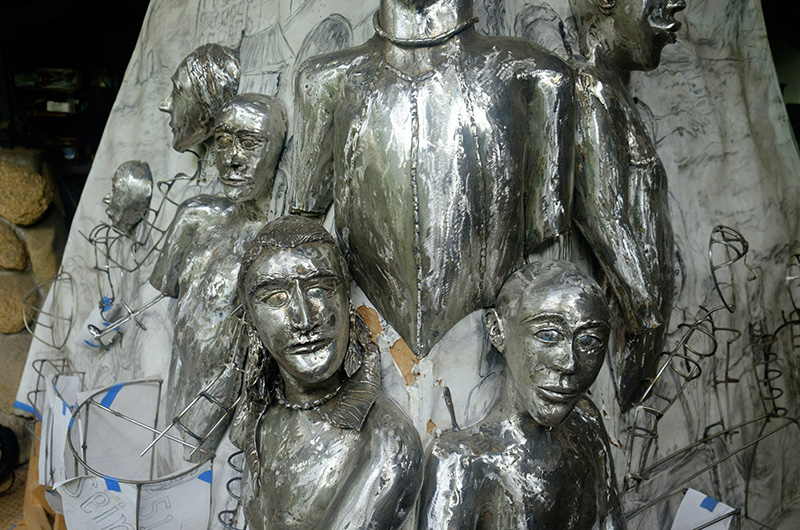Barney Zeitz is thinking big again.
In his home studio near Lake Tashmoo, the longtime Island artist has created monumental steel sculptures for the town of Plymouth (the Immigrant Memorial near Plymouth Rock), the Rhode Island Holocaust Museum and a community center in Great Barrington. Mr. Zeitz’s fused and stained glass work transforms the light entering both homes and houses of worship, including a church in Germany that began its life as a synagogue before the Nazi era.
His latest project enlarges—literally—the themes of community and inclusiveness that appear in Mr. Zeitz’s earlier works.
“This is probably going to be my last big solo piece,” he said, of the monument he is calling the Cornerstone Project.
A towering half-pyramid of stainless steel with human figures representing America’s cultural diversity, it is inscribed at the base with a dedication: “To the enduring memory of our ancestors who have enriched this land: indigenous peoples, immigrants, the enslaved, and refugees. Their descendants and newcomers will continue to build a strong and peaceful community.”
Destined for Fall River, where Mr. Zeitz was born and raised before making the Vineyard his home as a young man, the monument arose from a conversation on social media three years ago with Steven Camara, who at the time was a Fall River city council member.
“He saw what I was up to, and he asked me to come in to Fall River and talk about doing something,” Mr. Zeitz said. “We went around and looked at spaces, and we decided Government Center was the place, right on the corner where people congregate. Whether it’s protests or TV shoots with officials, they usually do it on that corner.”
“It’s really a prominent spot,” he added. “But it’s dead-looking. It’s empty looking. So this is the cornerstone.”
Mr. Zeitz and Mr. Camara envisioned the monument emerging from an angled wall on the plaza, with its human figures also emerging from a bas-relief background representing history.
“We’re looking to the future, but we’re also thinking to the past,” he said. “We decided, to really honor our ancestors, we had to include everybody.”
The central figure in the Cornerstone Project is a native American man, modeled at present on Cyrus Dallin’s 1921 statue of Massasoit. To sculpt the enslaved, Mr. Zeitz looked to Auguste St. Gaudens’s bronze relief in Boston depicting the 54th Regiment Massachusetts Volunteer Infantry of Black soldiers marching to fight in the Civil War.
But Mr. Zeitz is not letting the classical sculptures dictate the final form of his designs. In addition to asking local Wampanoag and Black acquaintances for their reactions, he is also planning to meet with community groups in Fall River to seek their comments and suggestions on how the different peoples—including a Cambodian girl and other immigrants—are represented.
“Anyone who comes by, whether they’re black or white or Asian—they’re going to look here and see someone they know, and feel connected,” he said.
Nine human figures in all will emerge from the bas-relief planes of the Cornerstone Project, Mr. Zeitz said. “My original drawing had three more people, (but) there just isn’t enough room once you make it three-dimensional.”
Mr. Zeitz said he has about another year of work to do on the sculpture, which is progressing more slowly than before the pandemic because his longtime assistant Gabe Bellebuono has not been able to help with the work.
“Two and a half hours of welding a day is as much as I can do,” Mr. Zeitz said.
The Cornerstone Project is now about 85 per cent funded with help from the Fall River business community, Mr. Zeitz said. To help close the funding gap, he is reviving a practice that helped him finish the set of windows for the German church: He is selling smaller artworks, both glass and steel, directly from his studio with a portion of proceeds going to underwrite the monument.
He’s also gone into the publishing business, making notecards and Dibond prints from 40 of the black and white drawings he has created while riding the ferry, attending concerts and people-watching at the beach. Some of the images first appeared in the Vineyard Gazette.
Printed on Island, the cards are available at some local retailers, he said. But when they’re purchased directly from Mr. Zeitz, 30 per cent of the sale will go to the Cornerstone Project.
Donors who contribute directly to the project will have their names stamped or inscribed on the monument, in lettering sized to the amount of their contributions.
“Anyone who gives even a dollar is going to have their name on it,” Mr. Zeitz said.
Before the Cornerstone Project heads to Fall River for installation, Mr. Zeitz said he would like to lend it to the Martha’s Vineyard Museum for display on its grounds next summer.
To see the work in progress and purchase art or cards directly from the artist, visitors may contact him on Facebook at Barney Zeitz Fine Art or by email at bz@bzeitz.com.








Comments (4)
Comments
Comment policy »